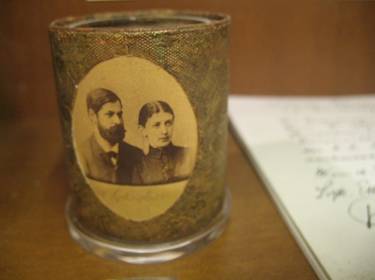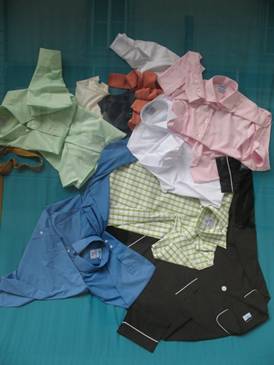The Splatter Technique
Rebekah Rutkoff

Napkin ring from the wedding of Sigmund Freud and Martha Bernays

Floral V, Morris Louis
An Interior Monologue Between the Narrator and Carolee Schneemann
1.
Q: When you introduced Hart of London, the Jack Chambers film, at Light Industry in Brooklyn, you said Chambers was a painter before he was a filmmaker.
A: He used aluminum spray paint straight from the can. You had to walk by to see the pieces completely: the image was dependent on light. He made Hart of London in the shadow of his own death. He was diagnosed with leukemia in 1968 and died 10 years later.
Q: Did he fall in love after the diagnosis?
A: No. His mother was dying of cancer in 1961 and he moved back to London from Madrid to be with her. So by the time he got sick he had already learned to acclimate to cancer. It wasn’t like some invigorating shock.
Q: I like the idea of the kind of man who would marry within a year of his mother’s death, with his sadness still at least semi-intact. The simplicity of the switch-over from one love object to another is touching—as if it indicates a kind of great sensitivity on his part. In my mind his lips darken and his eyelashes lengthen permanently, remaining forever just a touch moist from proximity to tears.
A: Grief works wonders for sexuality. But funeral sex is generally a woman’s domain—if she can find someone she doesn’t quite love but trusts—someone she can make demands on since all bets are off. It’s a rare chance to grieve, dissociate and achieve orgasm at once.
Q: I was taken by how soft you seemed the Hart of London night—you didn’t appear to be terribly stimulated by the sound of your own voice even with a microphone nearby, and yet you were open. And there was a man in the audience—a kind of middle-aged Jewish guy in fleece who seemed reliable. I assumed he was your boyfriend. I got the sense neither of you was over-extending yourself to acquire an identity.
A: I’ve had time. Sometimes you do need a man to provide a good dose of narcissism so you can dilute it in a bucket of lukewarm water—like a quarter teaspoonful of cranberry concentrate or indigo dye. It can be very effective for revving up desire. The challenge, of course, is to integrate that colored water into a loving, trustworthy relationship. You might be able to get your hands on the bucket, but you rarely get around to watering the garden.
Q: Is that how it is with the Jewish guy?
A: God, no. Later you’ll get to dropping out, down under desire—where it smooths out and the other person is jelly somehow—not jam, but jelly—you know, he holds his form, but you can still see his plainest self, below the radar. The cutting edge of gender softens, but not so much that it ruins the experience—it’s a non-requirement of the knife’s edge.
Q: Like those tall seven-layer cakes from New Jersey bakeries—that sensation of the vague border between layers as you cut down. Sometimes it’s even a two-handed endeavor in terms of guiding the knife. It’s a slide but there’s friction, and these cakes are expensive, too. They stay together under the outside shell. I’ve never understood women who like the over-ripe peach—some guy who will just split in two and the pit will come tumbling out.
A: It’s difficult to see others glide along on the gentle waves of love when you have to pause to make carvings into surfaces every few minutes.
Q: But you made drawings on your father’s prescription pills.
A: A fine-tipped pen on an uncoated tablet is fantastic—you can hear each stroke. You think you’re in so much control and a minute later the ink has bled into a giant spider web. If you don’t want a mess you can use a mechanical pencil.
Q: My dad once sensed that I might have a talent for illustration and asked me to copy a cereal box illustration at breakfast. I didn’t do a good job. One night we discovered that my brother could speak backwards when he was going to bed and called me “Hakeber” and my mom, whose name is Jane, “Enaj.” We tested to see if he could say some other words—first “Pluto” and then “antidisestablishmentarianism”—backwards, and he could.
A: You’re worried that you’re a masochist. Just ignore it until it goes away. That’s what happens in the onward march of female heterosexuality—one day you’ll wake up and the tension will be unsustainable. It will cease playing itself out in the theater of public histrionics and will go lie quietly in some kind of internal jewelry box, with velvet-lined drawers. Ideally at the end there’s grace and the phallus is as much yours as it is his. It’s a process that’s much too slow and unsightly for women to tell each other about—that’s why we’re always re-inventing the wheel. Each one has to deplete her own resources for herself. Plus can you imagine telling your daughter about this ahead of time? It would be like moving to Poland for good.

Copying the Old Masters, Kunst Historisches Museum, Vienna
2.
Q: Everyone wants to know who dripped first.
A: This surprises you?
Q: But you did a lot of smearing—and the Interior Scroll may have dripped.
A: Listen. It didn’t. Roger Vadim invented Brigit Bardot who invented the New Wave.
Q: The night after the Hart of London screening I dreamt that you taught a class on how to make a drip painting. The space was open, industrial and a long horizontal strip of raw canvas hung from the ceiling by hooks. Like a hand-made but perfectly timed machine, buckets of paint just above the canvas poured out their contents in sequential order from left to right, creating huge vertical spills down the swath. The film programmer Mark McElhatten ran down the length of the canvas in time with the pouring; he pulled each spill of paint down to the bottom edge of the canvas, and had to function in perfect timing with the whole mechanism. These spills came pouring down, one after the other, in fast succession, a sequence of colors. In the end it looks like a Morris Louis painting and it’s laid out on the ground. I chose a raw spot on the canvas—a place untouched by paint—and sat there. You said there should be no areas of canvas showing. But didn’t Morris Louis leave areas of raw canvas? I asked. Morris Louis was not an important painter, you replied. “I invented this method.”
I couldn’t believe that you had set this elaborate thing up just to teach us something. It was so thought-through, massive and delicate at once. I wanted to know if this was just a demo or a real painting. It turned out it was art and you were going to hang it in your retrospective.
A: We usually see the mark of the painter afterwards—we’re so pleased when a painting’s still got mountain ridges in it with a dried gloss on top—remnants of the process. But seeing the paintbrush distribute the paint is something else. And even in the Clouzot film about Picasso the main show is the battle between the camera and the brush. To keep the brushwork-in-process dilated is something else. Morris never did that. But he died the same year he was diagnosed with lung cancer, so he didn’t have a lot of time to push himself further.
Q: Did Ruth Kligman?
A: Did she push herself? No. Ruth remained vain but became more generous as she aged. She liked to recall the time Franz Kline confided in her about the pain of painting. “They think it’s easy. They don’t know it’s like jumping off a 12-story building every day.”

Strangers, Lucerne

Display of men’s shirts, Warsaw
Notes
Rebekah Rutkoff lives in Brooklyn, NY. She is completing a dissertation on the filmmaker Robert Beavers and American philosophy at the CUNY Graduate Center.